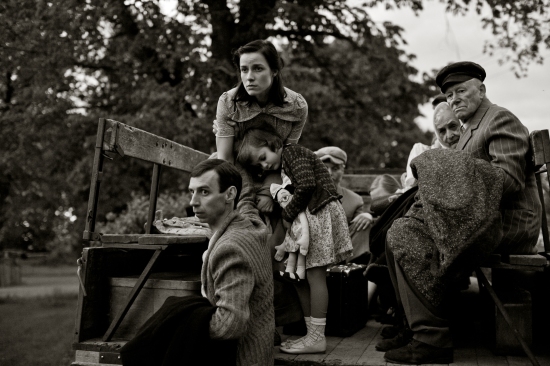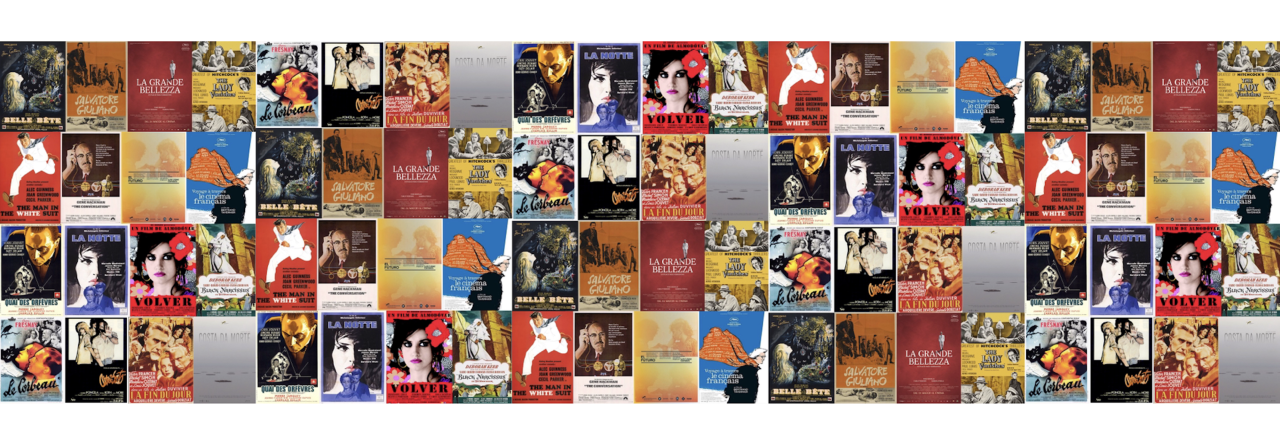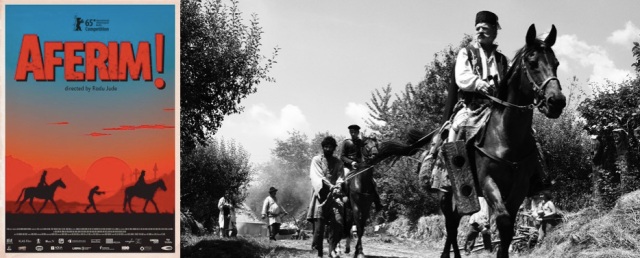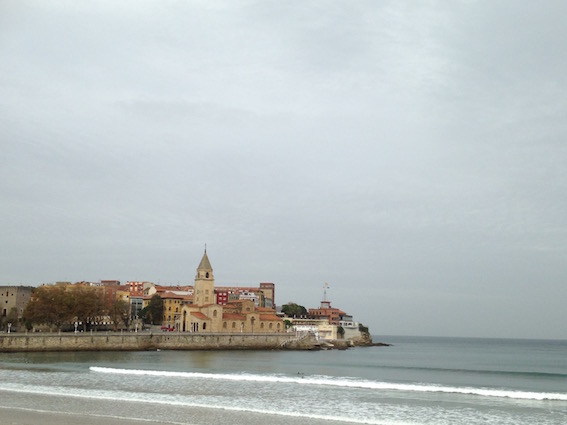
Sunday being a day of rest, it was only appropriate that I should catch up on some sleep (and also write the first of these postcards) – so the first film of the day for me wasn’t until 5pm.

Under Sandet / Land of Mine (Martin Zandvliet, 2015) – one of the Official Selection (competition) titles – is a Danish-German co-production that tells a little-known story from the aftermath of World War 2, namely that German soldiers were used to clear mine fields in countries that had been under Nazi occupation during the war. Some two million mines had been laid along Denmark’s western coast (someone apparently thought that it was a possible site for the Allied landings that would in reality occur in Normandy) presenting an obvious danger to the civilian population. 2,600 German troops (most of them teenagers recruited in the dying days of the war) were put to work defusing and removing the mines, having been told that they would only be allowed to go home to Germany once every mine had been recovered. The film gives two points of view: Sargent Carl Leopold Rasmussen (Roland Møller), an experienced Danish officer who is overtly and openly hostile towards the German forces who occupied his country (the English title obviously has the double meaning of ‘my land’ and ‘minefields’); and the young German soldiers (most notably Louis Hofmann, Emil Belton and Oskar Belton – the latter two play the team’s youngest members, a pair of twins who are barely in their teens) who he must train as a bomb disposal unit. If the treatment of what is an interesting story perhaps leans towards the conventional (the narrative arcs of certain characters is telegraphed from early on and although there are several sequences of high tension in relation to the bombs, that tension cannot be sustained for the duration (that said, I jumped in my seat at least three times)), the acting is great (a lot of it communicated silently through gesture and expression) and the characters are differentiated sufficiently for us to become invested in what happens to them as individuals.

The second film screening from the Convergencias selection was Risttuules / In the Crosswind (Martti Helde, 2014) – chosen by David Tejero (you can read his text on the film, here). I think that this will end up being my favourite of the festival (unless something astounding comes along) because it is utterly original in form and visualisation, and emotionally devastating – in contrast to the majority of screenings where people start chatting and filing out during the end credits, in this case you could have heard a pin drop and barely anyone got up from their seat until the credits had ended. This is another film that tells a little-known story in relation to World War 2: Stalin’s ethnic cleansing of the Baltic states from the early 1940s onwards involved thousands of citizens from Estonia, Lithuania, and Latvia being forcibly sent by train to remote outposts in Siberia. Their predicament continued after the war ended and most were unable to return to their homelands until some time after Stalin’s death in 1953.
In the Crosswind tells the story via a series of letters (heard in voiceover – there is no spoken dialogue in the film) based on those written by Erna Tamm (played by Laura Petersen) as if to her husband Heldur (Tarmo Song) after they were separated during the removals. But the most arresting feature are the black and white tableaux vivants through which Helde conveys those moments when time stands still for us at those junctures when our lives are irrevocably changed. People stand stock still, emotion frozen on their faces, captured in moments of rupture and turmoil. The camera moves through a given scene in one continuous take (as far as I recall) – with the sound continuing as if everything were in action – and the staging is ingeniously blocked-out in such as way so that the movement of the camera through the tableaux allows a set up to change without cutting. The best example of this is a sequence where the camera is moving through an interior and passes a series of windows with pillars of wall in between them – the camera keeps slowly moving and each time we see the view out of the window, the (frozen) action has moved on, telling a violent and horrific story. The effect is a bit like looking at individual frames – or still images – taken in succession. It is genuinely unlike anything I’ve seen before and I hope that I can see it again.

My last screening on Sunday was one of the FICXLab (experimental) sessions showing two films by Robert Nelson: Suite California & Stops Passes Part 1: Tijuana to Hollywood via Death Valley (1978) and Suite California & Stops Passes Part 2: San Francisco to Sierra Nevadas & Back Again (1978). I found the combination of sound and image to be quite discombobulating. Part 1 features a spoof of the narcotrafficante ‘genre’ border crossings and there is humour throughout, usually via the juxtaposition of sound and image, but what emerges across both parts is multi-faceted portrait of California. The recourse to historical facts and monuments – giving a kind of historical layer to the presentation of landscape and place – reminded me of James Benning’s Deseret (although in visual terms they are quite different, as is Nelson’s focus on people within the spaces he explores).

Monday started with The Sky Trembles and the Earth Is Afraid and the Two Eyes Are Not Brothers (Ben Rivers, 2015), another discombobulating film and I still don’t know quite what to make of it. It starts as a ‘making-of’-style documentary, showing Spanish director Oliver Laxe making his new film, Las Mimosas, in Morocco. The press kit probably has the best synopsis of what happens: ‘Shooting against the staggering beauty of the Moroccan landscape, from the rugged terrain of the Atlas Mountains to the stark and surreal emptiness of the Moroccan Sahara, with its encroaching sands and abandoned film sets, a director abandons his film set descending into a hallucinatory, perilous adventure of cruelty, madness and malevolence. A Paul Bowles story combined with observational footage forms a multi-layered excavation into the illusion of cinema itself’. My response to a film immediately after seeing it is usually a reaction – that is to say emotional rather than intellectual – and I only really start to form a coherent opinion when I begin writing. In this case, I think that I need to watch it again because my response feels like it’s stuck in reaction to the visuals (very beautiful and eerily strange) rather than engaging with what is going on at a deeper level. One to return to at a later date.

Next up was my chosen film for Convergencias – Transatlantique (Félix Dufour-Laperrière, 2014). This was the first time that I’ve introduced a film at a festival (or anywhere else other than a university) and led the subsequent Q&A, but my nerves were mainly about doing it in Spanish and making myself comprehensible to the audience (Félix spoke in French, which was then translated into Spanish by a translator). The original text that I had to submit as a proposal was almost 1,000 words but this then had to be edited and rewritten into a 200 word version for the festival catalogue:
‘Part meditative travelogue and part wordless maritime reverie, Transatlantique unfolds in the spaces of a cargo ship undergoing a transatlantic voyage between Antwerp and Montreal. The black and white cinematography registers the inkiest of blacks and blinding whiteness in the Atlantic’s unruly seascapes and, as the swaying motion of the ship causes a chiaroscuro dance on its surfaces, a complexly layered soundscape combines the sounds of the crew with audible elements of the ship and the encompassing sounds of the sea and wind in an evocative and transportive symphony.
This essay film is part of the trend for immersive documentaries, but its singularity resides in its relationship with the new silent cinema and the manner in which the film only offers a narrative in the sense that it begins in one place and ends in another; it is a stream of consciousness representation of the journey and the lives of those onboard rendered in an elegant and idiosyncratic visual form. It is fitting that a film exploring a ship at sea – an in-between space and no-man’s land in the interstices between national borders – uses the universal language of cinema at its most elemental to communicate with the audience.’
It was great to see the film on the big screen as my original viewing was on a computer (as I’ve said previously, I wasn’t able to see it in Edinburgh). Seeing it on that scale made certain things visible. David Cairns wrote about the film during EIFF and he mentioned ‘a breathtaking shot of the sea, blackly luminous’ and wondered whether it was played in negative – watching it for the second time, on a larger scale, and having recently seen Noite sem distancia (Lois Patiño, 2015), it seemed to me that the image was indeed one from elsewhere in the film flipped into negative. Someone asked about it during the Q&A and Félix confirmed that that was the case but that he had also digitally cut part of the image so as to remove the horizon line. I’ll be presenting the film again on Thursday.

I returned to the FICXLab screen for the last session on Monday, this time for a programme of shorts by Nathaniel Dorsky, Helga Fanderl, and Jonathan Schwartz. I’ve not seen any of their work before, so I didn’t really know what to expect. The programme was split into two, with Dorsky and Fanderl in the first half and then Schwartz in the second because the work of the first two complement each other whereas Schwartz’s films are quite different. The (silent) films by Dorsky (Prelude (2015) and Intimations (2015)) and Fanderl (Communing (2015)) have images of the natural world, repetition, reflection, and an emphasis on patterns of light and shadow in common (although the treatments are different), while Schwartz’s (a set of miniatures (2015), animals moving to the sound of a drum (2013), 3 1/33 series side a (2005-10), if the war continues (2012), 3 1/33 series side b (2005-10), Happy Birthday (2010)) utilise sound and the duplication of images to create worlds in miniature. My favourite of the evening was Fanderl’s film, although again my reaction was one of sensation rather than thought – but I’d like to see more of her films (which are shot on 16mm Super 8 and edited in camera). I will be writing a report for Desistfilm about the experimental section, so I won’t expand on these films any further for the time being.
To be continued…


































